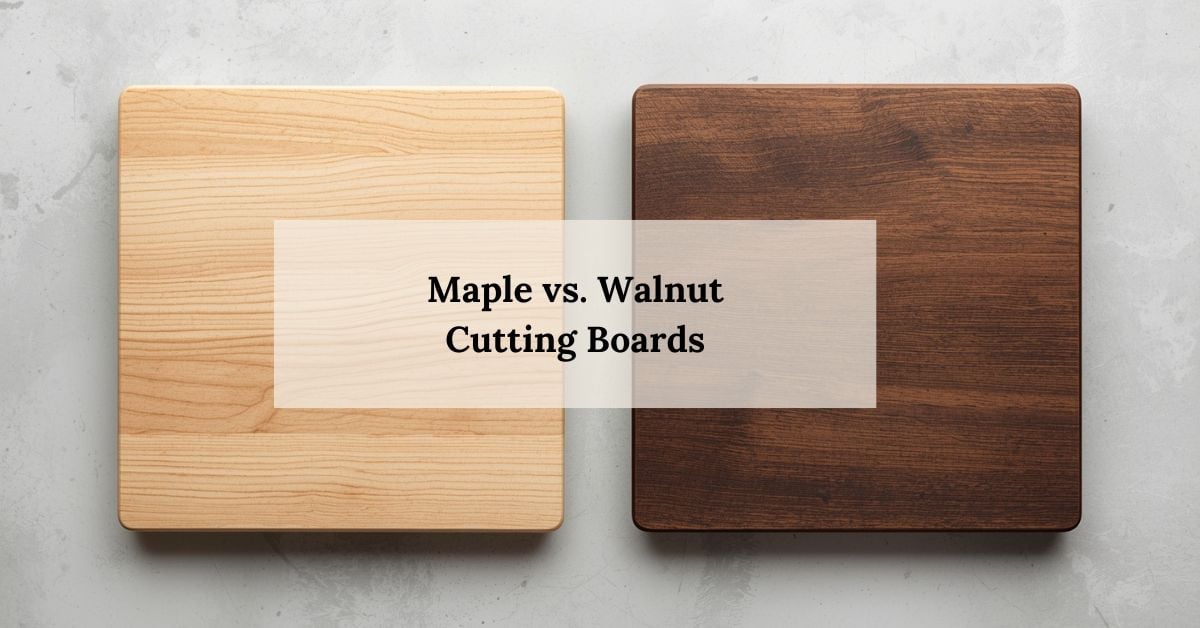Maple vs. Walnut Cutting Boards: The Complete Decision Guide

Choosing between maple and walnut for your cutting board feels like it should be simple – they’re both beautiful, both durable, both made from quality American hardwood. But the differences between them can significantly impact your satisfaction with your choice, especially when you’re adding personalization to the mix.
The Basic Differences That Actually Matter
Visual Impact Maple is light, clean, and classic – think fresh and timeless. Walnut is rich, dramatic, and sophisticated – think warm and luxurious. Your kitchen style and personal preferences probably already lean toward one of these aesthetics.
Aging Characteristics Both woods improve with age, but differently. Maple develops a warm, honey-colored patina over time while maintaining its fundamentally light appearance. Walnut deepens into richer, more complex tones, developing character that becomes more striking with use.
Cost Considerations Maple generally costs less than walnut for comparable quality. This isn’t about one being “cheap” – maple is excellent wood. Walnut simply commands premium pricing due to its slower growth rate and higher demand.
How Personalization Shows Up
Maple: Maximum Contrast Laser engraving and carved personalization show up dramatically against maple’s light background. If you want your family name, initials, or dates to be clearly visible and make a strong visual statement, maple delivers exceptional contrast.
Walnut: Elegant Subtlety Personalization on walnut creates sophisticated contrast between the carved areas and the dark wood. It’s elegant rather than bold, refined rather than dramatic. The effect is more understated but arguably more luxurious.
Practical Performance Differences
Knife Friendliness Both woods are gentle on knife edges, but there are subtle differences. Maple is slightly harder, providing excellent stability for cutting while still being forgiving on blades. Walnut is a touch softer, which some people prefer for extensive knife work.
Stain and Wear Visibility This is where the woods really differ. Maple shows stains, wear marks, and scratches more readily because of its light color. Walnut hides these same signs of use much better, maintaining a cleaner appearance over time with less maintenance effort.
Cleaning and Maintenance Both require the same care – hand washing, immediate drying, monthly oiling. But maple shows when it needs attention more clearly, while walnut can mask the need for maintenance. Some people prefer maple’s honesty, others appreciate walnut’s forgiveness.
Matching Your Actual Needs
Choose Maple If:
- You want personalization to be highly visible
- You prefer lighter, cleaner aesthetics
- Budget is a significant consideration
- You like seeing exactly when your board needs cleaning
- Your kitchen has lighter colors or modern styling
- You want something that photographs well for social media
Choose Walnut If:
- You prefer rich, sophisticated appearances
- You want something that hides wear and stains better
- You’re comfortable with premium pricing for premium looks
- You appreciate wood grain patterns and natural variation
- Your kitchen has warmer, traditional styling
- You want something that feels substantial and luxurious
Real-World Usage Scenarios
For Daily Family Use Maple might be more practical – you can see when it needs cleaning, personalization is clearly visible for family identity, and it costs less for larger sizes that handle family meal prep.
For Entertaining and Presentation Walnut often wins for serving and display purposes. It provides an elegant backdrop for cheese, charcuterie, or bread presentations, and the sophisticated appearance impresses guests.
For Gift-Giving Consider the recipient’s style and kitchen. Maple works beautifully for modern homes, first apartments, or when you want bold personalization. Walnut suits traditional kitchens, experienced cooks, or when you want to give something that feels premium.
The Personalization Factor
Text and Font Considerations Complex fonts and detailed designs often show better on maple due to the contrast. Simple, bold personalization can look elegant on either wood, but intricate details benefit from maple’s light background.
Size of Personalization Large, bold personalization works on both woods. Small, delicate personalization shows up better on maple. Consider how much detail you want visible in your customization.
Longevity and Heirloom Potential
Both Age Beautifully Quality boards of either wood can last generations with proper care. Maple develops warm character while maintaining its essential lightness. Walnut becomes richer and more distinguished with age.
Maintenance Reality Neither wood is high-maintenance, but walnut is more forgiving of occasional neglect. Maple shows when it needs attention, which can be positive (you know when to care for it) or negative (it’s less forgiving of busy schedules).
Making the Final Decision
Consider Your Priorities:
- Visual impact of personalization: Maple wins
- Sophisticated appearance: Walnut wins
- Budget consciousness: Maple wins
- Hiding wear and stains: Walnut wins
- Kitchen style matching: Depends on your aesthetic
- Gift appropriateness: Depends on recipient
Don’t Overthink It Both are excellent choices that will serve you well for years. Your initial aesthetic preference is probably the best guide – if you’re drawn to light, clean looks, choose maple. If you prefer rich, warm appearances, choose walnut.
The Bottom Line
There’s no “better” choice between maple and walnut – only the better choice for you. Maple offers maximum personalization visibility and classic appeal at a friendlier price point. Walnut provides sophisticated luxury that ages gracefully and hides the inevitable signs of a well-used kitchen tool.
Consider how you’ll actually use the board, what aesthetic makes you happy, and whether the personalization or the wood itself is the star of the show. Either choice will give you a beautiful, functional piece that can last decades.
Still deciding? Both maple and walnut create stunning personalized cutting boards – the choice comes down to whether you want bold contrast or sophisticated elegance.